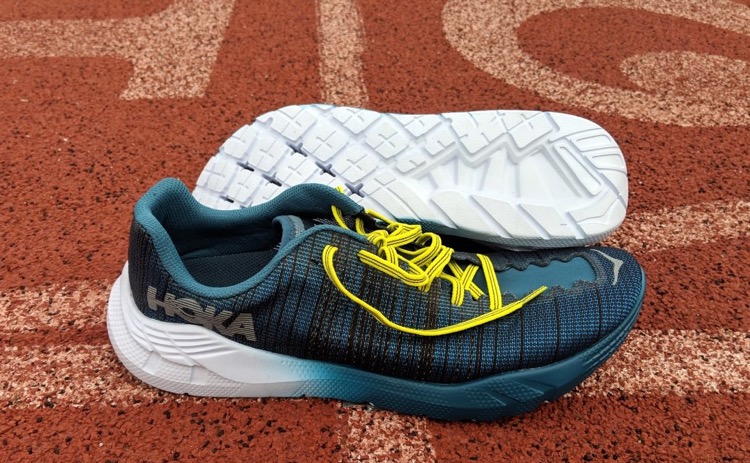 Our reviews are 100% organic. We do not accept payment for reviews or bundle with advertising budgets. In most cases, the brand is providing the product to our reviewers free of charge.
Our reviews are 100% organic. We do not accept payment for reviews or bundle with advertising budgets. In most cases, the brand is providing the product to our reviewers free of charge. Specs:
- Weight: 6.7oz men’s, 5.8oz women’s
- Stack heights:
- Men’s: 17mm rearfoot, 13mm forefoot
- Women’s: 15mm rearfoot, 11mm forefoot
- Heel-toe drop: 4mm
- Upper: MATRYX lightweight weave with Kevlar strands
- Midsole and outsole: Single density rubberized foam outsole, cored in forefoot to reduce weight
- MSRP: $140

The EVO series is HOKA One One’s in-house, high performance workshop where the production team works with the company’s elite athletes. The primary goal is to experiment with new designs and material formulations in order to build shoes for speed. The EVO Rehi is a great example of that process in action. It’s an outstanding shoe that tweaks the HOKA model to provide one of the fastest road or track shoes you’ll find on the shelf. It is intended for shorter distance road racing, but we’ve been using them for a couple months of track workouts in our continual (and increasingly difficult) quest to build and maintain base speed.
A key distinction of the EVO Rehi compared to other HOKA models is somewhat deceptive at first glance. The stack heights are practically minimalist which makes the shoe ride more like a racing flat than an everyday trainer. There’s a large section of foam that wraps the base of the rearfoot to give the appearance of large stack heights, but your heel actually sits down inside the foam fairly far, so the EVA surrounding it serves as more of a stabilizing purpose than cushioning. The cushioning that remains underfoot is remarkably responsive, with a slightly firm landing that quickly translates your impact into forward momentum and toe spring. With no rubber outsole between your feet and the ground, running with the Rehi on an all-weather track gives the effect of a quick turnover, almost without feeling the ground force beneath you.

Single density midsole-outsole combo; cutout holes in forefoot for lightness and flexibility.
Another distinction is apparent as soon as you take the shoe out of the box. It’s insanely light thanks to HOKA’s lightweight rubberized foam, as well as the extremely lightweight upper construction. The Rehi uses the same Matryx mesh first introduced on last year’s EVO Mafate. It is interwoven with thin Kevlar strands that provide structure and strength with minimal weight. Kevlar doesn’t absorb water, thus helping the uppers stay light even when wet. The only downside of Kevlar is that it doesn’t have inherent stretch properties, so there’s a thin stretchy panel on the center of the vamp to provide a bit of flexibility. (This same panel will also be on the upcoming Evo Mafate 2.) The strong stability of Kevlar allows the rest of the Rehi upper to be completely stripped down without overlays or heel counters that add extra weight.

Roomy forefoot last with center stretch panel.
One final deviation from typical HOKA construction is very much to our liking: the forefoot toe box is wider than most HOKA models, and can accommodate a large range of users. The fit is streamlined just enough to prevent sloppiness or excess movement, but roomy enough to wear comfortably for 60 to 90 minutes of hard running. One tip we found helpful was to keep the forefoot laces looser, with more tension higher up the instep.
Obviously, the lack of outsole rubber means any gait asymmetries will become magnified over time, and deterioration will happen more quickly on asphalt or concrete than on a track. While we’ve found impressive durability in ours after about 150 total miles on the track, the Rehi isn’t intended to be a high-mileage, everyday workhorse – it’s more of a specialized tool for fast training or racing efforts. With that purpose in mind, it’s one of the best we’ve tested.
The HOKA EVO Rehi is available in men’s and women’s versions at www.hokaoneone.com.


2 comments
I’d love to try these – if they made them in wide/double wide. Their wides aren’t wide enough for me (need 4E width) but maybe their wider shaping in wide sizing would work.
Bought my recent pair of Bondi 6 in 2E and they were a bit tight at first but stretch-out enough over the first two weeks of running and now fit great…just a thought.
Comments are closed.